American ginseng
| American ginseng | |
|---|---|
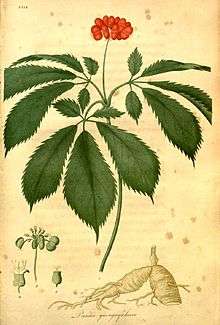 | |
| Panax quinquefolius[1] | |
| Scientific classification | |
| Kingdom: | Plantae |
| (unranked): | Angiosperms |
| (unranked): | Eudicots |
| (unranked): | Asterids |
| Order: | Apiales |
| Family: | Araliaceae |
| Subfamily: | Aralioideae |
| Genus: | Panax |
| Species: | P. quinquefolius |
| Binomial name | |
| Panax quinquefolius L. | |
American ginseng (Panax quinquefolius, Panacis quinquefolis) is a herbaceous perennial plant in the ivy family, commonly used as Chinese or herbal medicine. An extract is sold as Cold-fX. It is native to eastern North America, though it is also cultivated in places such as China.[3][4]
There is little evidence to support that American ginseng is effective against the common cold.[5][6] All trials evaluating the efficacy were funded by the manufacturer and there has been poor data reporting.[5] Health Canada's Natural Health Product Directorate states that it claims to "help reduce the frequency, severity and duration of cold and flu symptoms by boosting the immune system".[7]
The plant's forked root and leaves were traditionally used for medicinal purposes by Native Americans. Since the 18th century, the roots have been collected by "sang hunters" and sold to Chinese or Hong Kong traders, who often pay very high prices for particularly old wild roots.[8] It is also known by its Chinese name huaqishen (simplified Chinese: 花旗参; traditional Chinese: 花旗參; pinyin: huāqíshēn; Jyutping: faa1kei4sam1; literally: "Flower Flag ginseng") or xiyangshen (simplified Chinese: 西洋参; traditional Chinese: 西洋參; pinyin: xīyángshēn; Jyutping: sai1joeng4sam1; literally: "west ocean ginseng").
Medical uses
There is no evidence that American ginseng is effective in those infected with the common cold.[5] The effect of preventive use is not clear.[5] When used preventively it makes no difference on the rate of infections.[6] It also appears to have no effect on how severe the infections are.[6] There is tentative evidence that it may lessen the length of sickness when used preventively.[6]
Adverse effects
Individuals requiring anti-coagulant therapy such as warfarin should avoid use of American ginseng. Not recommended for individuals with impaired liver or renal function. It is not recommended in those who are pregnant or breastfeeding. Other adverse effects include: headaches, anxiety, trouble sleeping and an upset stomach.[5]
Recent studies have shown that through the many cultivated procedures that American ginseng is grown, fungal molds, pesticides, and various metals and residues have contaminated the crop. Though these contaminating effects are not considerably substantial, they do pose health concerns that could lead to neurological problems, intoxication, cardiovascular disease and cancer. However, the ginseng, wild or farmed, medically has the same effects in the body.[9]
Production
American ginseng was formerly particularly widespread in the Appalachian and Ozark regions (and adjacent forested regions such as Pennsylvania, New York and Ontario), due to its popularity and unique habitat requirements, the wild plant has been overharvested, as well as lost through destruction of its habitat, and is thus rare in most parts of the United States and Canada.[10] Ginseng is also negatively affected by deer browsing, urbanization, and habitat fragmentation.[11] It can also be grown commercially, under artificial shade, woods cultivated, or wild-simulated methods and is usually harvested after three to four years depending on cultivation technique; the wild-simulated method often requires up to 10 years before harvest.
Ontario, Canada is the world's largest producer of North American ginseng.[12] Marathon County Wisconsin, accounts for about 95% of production in the United States.[13]
-

American ginseng in human figure
-

Under wooden shade, American ginseng in late fall at Monk Garden in Wisconsin
-

A picture of the American Ginseng plant with fruit.
-

An image of the American Ginseng plant with a bud that will produce fruit.
-

American ginseng berries are ripe by late fall in Wisconsin.
-

A drawn image of the fruit and leaf of the American Ginseng plant
-

A drawn image of the American ginseng plants leaves
-
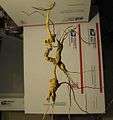
American wild ginseng root (Panax quinquefolius). This is a very old specimen, showing over 60 growth scars.
-
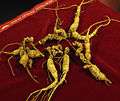
American wild ginseng root (Panax quinquefolius). Very old roots, ranging from 40–60 growth scars.
-

American wild ginseng root (Panax quinquefolius). This is a very old specimen, showing over 60 growth scars.
-
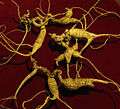
American wild ginseng root (Panax quinquefolius). Very old roots, ranging from 40–65 growth scars.
Chemical components
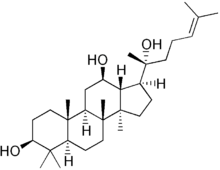
Like Panax ginseng, American ginseng contains dammarane-type ginsenosides, or saponins, as the major biologically active constituents. Dammarane-type ginsenosides include two classifications: 20(S)-protopanaxadiol (PPD) and 20(S)-protopanaxatriol (PPT). American ginseng contains high levels of Rb1, Rd (PPD classification), and Re (PPT classification) ginsenosides—higher than that of P. ginseng in one study.[14]
Pharmacokinetics
When taken orally, PPD-type ginsenosides are mostly metabolized by intestinal bacteria (anaerobes) to PPD monoglucoside, 20-O-beta-D-glucopyranosyl-20(S)-protopanaxadiol (M1).[15] In humans, M1 is detected in plasma from seven hours after intake of PPD-type ginsenosides and in urine from 12 hours after intake. These findings indicate M1 is the final metabolite of PPD-type ginsenosides.[16]
M1 is referred to in some articles as IH-901,[17] and in others as compound-K.[16]
Society and culture
Cold-fX is a product derived from the roots of North American ginseng (Panax quinquefolius). Originally manufactured by Afexa Life Sciences Inc. (formerly called CV Technologies Inc.),[18] headquartered in Edmonton, Alberta, Canada, the company and lead product was acquired by Valeant Pharmaceuticals International (headquartered in Laval, Quebec, Canada) in 2011.
The makers of Cold-fX, were criticized for making health claims about the product that have never been tested or verified scientifically. Up until February 2007, the company advised a regimen of 18 pills over a course of 3 days in order to obtain "immediate relief" from a cold. Health Canada's review of the scientific literature confirmed that this is not a claim that CV Technologies Inc. is entitled to make.[19]
Distribution

American Ginseng can be found in much of the eastern and central United States and in part of southeastern Canada.[20] It is found primarily in deciduous forests of the Appalachian and Ozark regions of the United States.[21] American ginseng is found in full shade environments in these deciduous forests underneath hardwoods.[22] Due to this very specialized growing environment and its demand in the commercial market it has started to reach an endangered status in some areas. It can be found in the following states and provinces:
Alabama, Arkansas, Connecticut, Delaware, Georgia, Illinois, Indiana, Iowa, Kentucky, Maine, Massachusetts, Maryland, Michigan, Minnesota, Mississippi, Missouri, Nebraska, New Hampshire, New Jersey, New York, North Carolina, Ohio, Oklahoma, Ontario, Pennsylvania, Quebec, South Carolina, South Dakota, Tennessee, Vermont, Virginia, West Virginia, and Wisconsin. [23]
Endangered Status
American Ginseng is not listed as an endangered species across the United States of America but it has been declared as a part of the endangered species scale by some states. States that recognize American Ginseng as endangered: Maine, Rhode Island. States that Recognize American Ginseng as Vulnerable: New York, Pennsylvania. States that Recognize American Ginseng as Threatened: Michigan, New Hampshire. States that Recognize American Ginseng as Special Concern: Connecticut, Massachusetts, North Carolina, Tennessee. [20]
References
- ↑ Panax_quinquefolius L., from "American medical botany being a collection of the native medicinal plants of the United States, containing their botanical history and chemical analysis, and properties and uses in medicine, diet and the arts" by Jacob Bigelow,1786/7-1879. Publication in Boston by Cummings and Hilliard,1817-1820.
- ↑ "Panax quinquefolius". NatureServe Explorer. NatureServe. Retrieved 2007-07-03.
- ↑ Xiang, Q.; Lowry, P. P. (2007). "Araliaceae". In Wu, Z. Y.; Raven, P. H.; Hong, D. Y. Flora of China (pdf). 13. St. Louis, MO: Missouri Botanical Garden Press. p. 491. ISBN 9781930723597.
- ↑ "Panax quinquefolius". eFloras.
- 1 2 3 4 5 Nahas, R; Balla, A (Jan 2011). "Complementary and alternative medicine for prevention and treatment of the common cold.". Canadian Family Physician. 57 (1): 31–6. PMC 3024156
 . PMID 21322286.
. PMID 21322286. There are no trials evaluating ginseng for treatment of the common cold.
- 1 2 3 4 Seida, JK; Durec, T; Kuhle, S (2011). "North American (Panax quinquefolius) and Asian Ginseng (Panax ginseng) Preparations for Prevention of the Common Cold in Healthy Adults: A Systematic Review.". Evidence-based complementary and alternative medicine : eCAM. 2011: 282151. doi:10.1093/ecam/nep068. PMC 3136130
 . PMID 19592479.
. PMID 19592479. - ↑ http://webprod3.hc-sc.gc.ca/lnhpd-bdpsnh/info.do?lang=eng&licence=80002849
- ↑ There is More to a Forest than Trees. research.vt.edu (Summer 2002)
- ↑ Wang, Zengui; Huang, Linfang (March 2015). "Panax quinquefolius: An overview of the contaminants". Phytochemistry Letters. 11: 89–94. doi:10.1016/j.phytol.2014.11.013.
- ↑ Beattie-Moss, M. (2006-06-19). "Roots and Regulations - The unfolding story of Pennsylvania ginseng". Pennstate news.
- ↑ McGraw, J. "Population Biology and Conservation Ecology of American Ginseng". West Virginia University.
- ↑ "Industry Information | Ontario Ginseng Growers Association". http://ginsengontario.com/. Ontario Ginseng Growers Association. Retrieved July 12, 2015. External link in
|website=(help) - ↑ "Ginseng Prices at Highest in Decades". The Post Crescent. October 19, 2010.
- ↑ Zhu, S.; Zou, K.; Fushimi, H.; Cai, S.; Komatsu, K. (2004). "Comparative study on triterpene saponins of ginseng drugs". Planta Medica. 70 (7): 666–677. doi:10.1055/s-2004-827192. PMID 15303259.
- ↑ Hasegawa, H.; Sung, J.-H.; Matsumiya, S.; Uchiyama, M. (1996). "Main ginseng saponin metabolites formed by intestinal bacteria". Planta Medica. 62 (5): 453–457. doi:10.1055/s-2006-957938. PMID 8923812.
- 1 2 Tawab, M. A.; Bahr, U.; Karas, M.; Wurglics, M.; Schubert-Zsilavecz, M. (2003). "Degradation of ginsenosides in humans after oral administration". Drug Metabolism and Disposition. 31 (8): 1065–1071. doi:10.1124/dmd.31.8.1065. PMID 12867496.
- ↑ Oh, S.-H.; Lee, B.-H. (2004). "A ginseng saponin metabolite-induced apoptosis in HepG2 cells involves a mitochondria-mediated pathway and its downstream caspase-8 activation and Bid cleavage". Toxicology and Applied Pharmacology. 194 (3): 221–229. doi:10.1016/j.taap.2003.09.011. PMID 14761678.
- ↑ "What is COLD-fX intended for?". Cold-fX: Frequently Asked Questions. Retrieved 2007-11-24.
- ↑ Charlie Gillis (2007-03-26). "COLD-fX catches the sniffles again". Macleans Magazine. Archived from the original on 2012-02-07.
- 1 2 U.S. Government, USDA. "Panax quinquefolius L.". Plants Database. USDA. Retrieved 6 December 2015.
- ↑ U.S. Government, Fish and WIldlife Service. "American Ginseng". International Affairs. United States Fish and Wildlife Services. Retrieved 6 December 2015.
- ↑ Anderson, Kat. "American Ginseng" (PDF). Plant Guide. Retrieved 6 December 2015.
- ↑ "Taxon: Pana quinquefolius L.". National Plant Germplasm System. Retrieved 6 December 2015.
External links
| Wikispecies has information related to: Panax quinquefolius |
| Wikimedia Commons has media related to Panax quinquefolius. |
- "There is More to a Forest than Trees" by Lynn Davis, College of Natural Resources, Virginia Tech
- "Roots and Regulations: The Unfolding Story of Pennsylvania Ginseng", by Melissa Beattie-Moss
